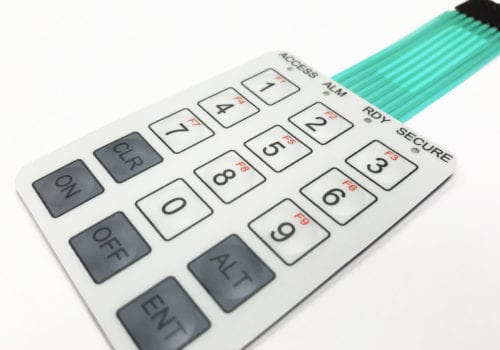The Function of a Membrane Switch in Modern Touch Interfaces and Controls
The Function of a Membrane Switch in Modern Touch Interfaces and Controls
Blog Article
Recognizing the Performance of Membrane Layer Changes for Customer User Interface Gadget
The functionality of membrane layer switches represents a considerable development in individual interface style, combining performance with visual flexibility. As sectors significantly focus on customer experience, comprehending the nuances of membrane button innovation ends up being important.
What Are Membrane Layer Switches?
Membrane switches are cutting-edge user interface gadgets that facilitate customer interaction with electronic equipment. These functional elements include numerous layers, consisting of a visuals overlay, spacer, and a printed circuit layer. The design enables a smooth integration right into various electronic devices, enhancing both the aesthetic and practical elements of interface.
Membrane buttons are typically employed in a vast array of applications, from house home appliances to industrial equipment and medical tools. Their building and construction normally features a thin profile, making them an excellent option for portable designs. The tactile responses offered by these switches can be engineered to satisfy certain customer preferences, ensuring reliable interaction in between the customer and the gadget.
Durability is one more significant benefit of membrane layer buttons, as they are resistant to dust, wetness, and chemicals, which enhances their life expectancy in requiring atmospheres. Furthermore, these switches can be customized in regards to shape, dimension, and visuals layout, permitting for branding and user-specific functions. Generally, membrane layer switches over represent a sensible service for boosting customer experience in digital gadgets, combining functionality with visual allure in an efficient manner.
Just How Membrane Layer Changes Job
Operating on an uncomplicated principle, membrane layer switches over make use of a layered building and construction to register individual input efficiently. Each switch contains several layers, consisting of a printed circuit layer, a spacer layer, and a leading graphic layer, which are created to work with each other effortlessly. When a customer presses the top layer, it presses the spacer layer, bringing the conductive components of the circuit layer into contact with each other.
This call creates a shut circuit, signifying the device to implement a details feature. The layout enables for various arrangements, consisting of responsive responses, which can boost the user experience by offering a physical sensation upon activation. The products used in membrane layer buttons frequently consist of adaptable substratums, such as polyester or polycarbonate, which make certain resilience and durability against damage.

Trick Benefits of Membrane Layer Buttons

An additional significant advantage is their density. Membrane layer switches are slim and lightweight, which enables suppliers to conserve room in their gadgets without sacrificing performance. This function is particularly valuable in applications where weight and volume are critical factors Discover More to consider.
Furthermore, membrane switches are immune to dust, dampness, and chemicals, boosting their longevity. This durability expands their lifespan and decreases the requirement for regular substitutes, leading to price savings with time.
Furthermore, the responsive feedback supplied by membrane switches can be enhanced to boost customer interaction. They can consist of features such as raised buttons or distinct clicks, boosting use and individual experience.
Applications Throughout Industries
User user interface devices using membrane switches prevail in a broad array of markets, showcasing their adaptability and capability. Membrane Switch. In the clinical sector, membrane layer switches are important to devices such as analysis tools and patient tracking systems, where their longevity and convenience of cleaning are crucial for keeping hygiene criteria. In the automobile market, these switches are utilized in dashboard controls and infomercial systems, supplying a smooth and contemporary interface for individuals.
Furthermore, the consumer electronic devices field gain from membrane layer switches in appliances and handheld devices, where small design and easy to use interfaces boost customer experience. Industrial applications additionally utilize membrane layer switches over for control board in machinery and automation systems, highlighting their effectiveness and resistance to harsh environments.
In find here the aerospace and protection markets, membrane buttons are utilized in cockpit controls and devices, where dependability and performance under extreme conditions are use this link paramount. In addition, the pc gaming market increasingly incorporates membrane layer switches in controllers and arcade equipments, adding to an engaging customer experience. On the whole, the flexibility of membrane changes enables their widespread usage across various fields, underscoring their value in contemporary interface layout.
Future Patterns in Membrane Layer Change Modern Technology

Furthermore, making use of sophisticated products, such as polycarbonate and polyester movies, is expected to increase, providing enhanced toughness and resistance to environmental stressors. These materials add to the total longevity of membrane switches, making them appropriate for harsher commercial applications.
Moreover, the unification of smart technology, consisting of IoT connection, will certainly make it possible for membrane switches to interact with other devices and systems, assisting in an extra interactive individual experience. This fad lines up with the growing demand for wise tools throughout various industries, from health care to customer electronic devices.
Last but not least, customization alternatives are expected to broaden, permitting suppliers to develop bespoke solutions tailored to specific user demands and choices. These developments will certainly position membrane layer buttons as important elements in the evolution of interface technology.
Final Thought
In verdict, membrane layer switches over represent an essential innovation in individual interface modern technology, providing a dependable and versatile remedy for varied digital applications. As advancements in product science and touch picking up innovations proceed, the functionality and applicability of membrane layer switches are anticipated to broaden, reinforcing their relevance in contemporary digital tools.
Report this page